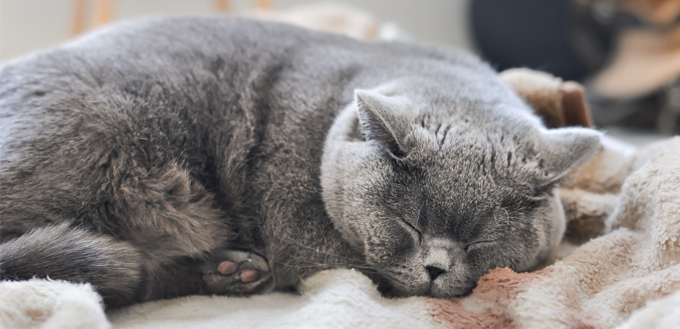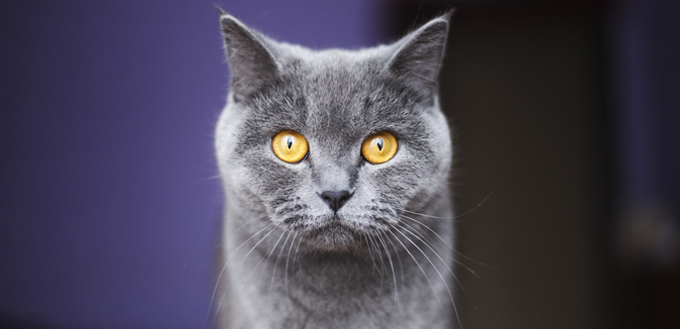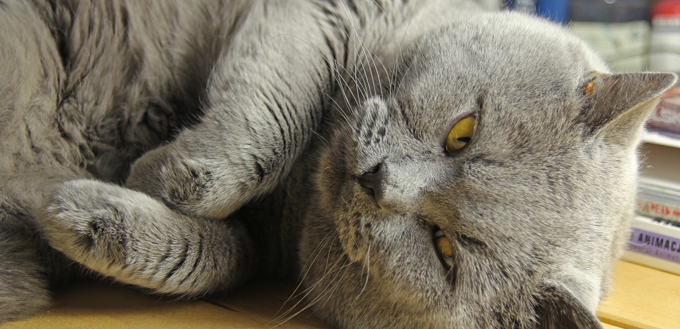Not many people realize that they most likely grew up with a British Shorthair Cat. Fans of Lewis Carroll’s Alice in Wonderland will know the Cheshire Cat with its now-iconic mischievous grin. Then there’s Shrek’s swashbuckling, honorable, and fiercely loyal feline Puss in Boots. It’s a muscular and solid kitty that is made adorable by its easygoing personality. It may have the reserved temperament of its British forebears, but the British Shorthair can be the most affectionate, most loving cat you’ll ever get once you get to know it.

History of the British Shorthair Cat
The British Shorthair Cat is described by many as one of the oldest cats on the planet, probably having descended from Egyptian domestic cats that were brought to British shores when the Roman Empire expanded westwards in the 1st century AD. Nobody knows what became of these kitties. What many do know is that they have probably interbred with the wildcat population of the British Isles.
Over the course of many centuries, the interbred cats slowly developed a character of their own, largely different from their Egyptian and local British forebears. They developed thicker coats to better suit them to the colder climes of the islands unlike in the scorching landscape of Egypt. They retained the short coat of their Egyptian ancestors however. What is more amazing is that the modern British Shorthair is not that different from the very first of these solid, muscular, robust, large, and thick-coated kitties.
By the 19th century, fans of the British Shorthair began an extensive process of selective breeding in an effort to produce what was to become the English type of well-muscled, round-faced kitty. They also called this cat as the British Blue, perhaps to differentiate it from the Russian Blue from the port city of Arkhangel’sk in northern Russia.
In 1871, the British Shorthair was finally showcased to the world of cat fanciers when the very first cat show of its kind was organized and held at the Crystal Palace. It was an instant hit. Too bad, the introduction of the Persian by the early 1890s saw a reduction of interest in the British Shorthair.
When World War I broke out, British Shorthair breeding stock was further reduced to dangerously low levels. To somehow arrest this decline, British Shorthairs were bred with Persians to create the British Longhair. They were crossed, too, with Russian Blues to create the Blue Shorthair. Some breeders introduced the French Chartreux in an attempt to reestablish the characteristics of the British Shorthair. The Chartreux was genetically different, but had the looks of a British Shorthair.
It took breeders many years before the British Shorthair they were working to reestablish finally got the recognition from The International Cat Association and the American Cat Fanciers’ Association in the late 1970s. The American Cat Association recognized the breed as early as 1967, however. And it took the Cat Fanciers’ Association until 1980 to give its full recognition. As of 2018, the British Shorthair is recognized by all cat associations.
By 2013, the British Shorthair has retaken its place in the British Isles as the country’s most popular pedigreed kitty.
Quick Facts About the British Shorthair Cat
This British kitty has come a long way from being an Egyptian domestic cat and a Roman Legion companion to becoming one of the cat-loving world’s most endearing felines. Here are some quick facts you really have to know about this British kitty in the event that you want to get your own.
- Male British Shorthairs typically weigh between 9 and 17 pounds while females are lighter at 7 to 12 lbs.
- On the average, British Shorthairs can grow anywhere from 12 to 14 inches.
- It can reach the ripe age of 17 years, although the minimum they can live is 12. Some British Shorthairs are also known to reach 20 years.
- British Shorthairs have a powerful look with strong and thick legs coupled with rounded paws.
- The head is round and large with a rather short muzzle and very broad cheeks.
- The ears are large, broad, and set wide apart.
- The tail is medium in length and comes with a blunted tip.
- British Shorthairs take about 3 years before they reach their full maturity.
- Its coat is dense. Surprisingly, there’s no undercoat.
- The most familiar variant of the British Shorthair is the British Blue, although it can also come in fawn, cinnamon, red, black, white, golden, silver, and cream.
- The coat can be solid or come in various patterns like bicolor, colorpoint, shaded, tortie, and tabby.
- British Shorthairs with tabby patterns can come with classic, mackerel, ticked, or spotted patterns.
- British Shorthairs with non-tabby patterns typically show tortie, bicolor, bicolor-and-white, tipped-and-colorpointed, and smoke.

Things You Should Know About the British Shorthair Cat
Being one of the most popular pedigreed feline breeds doesn’t automatically mean the British Shorthair is perfect for anyone. Like any other pet, this British kitty has a certain personality that requires a perfect match. On top of that, there are some things that every wannabe British Shorthair owner should really think about.
Health
This kitty is generally considered robust with its muscular appearance and well-toned look. However, like all cats, it is possible that this kitty can have the dreaded genetic disease marker for hypertrophic cardiomyopathy where the muscles of the heart grow in size until it squeezes the heart itself and can no longer pump blood efficiently. This is a very common disorder that can be passed down generations. As such, it is imperative that the British Shorthair be subjected to DNA testing to help identify for the genetic marker that codes for such a disease as well as other diseases.
Another health issue that is quite common among British Shorthairs is hemophilia B. In this condition, the kitty lacks a certain blood clotting factor known as Factor IX. Without this substance, any form of bleeding will be inadequately controlled which can lead to hypovolemia, anemia, and even hypovolemic shock. Like hypertrophic cardiomyopathy, there’s DNA screening for hemophilia B.
There is another genetic disease that can affect this kitty: polycystic kidney disease. The small tubes inside the kidneys do not look normal, leading to a reduction in its function. Over time, this can result in kidney failure.
Perhaps the most important health concern among owners of British Shorthairs is the tendency of their cats to become obese. This is understandable. This type of cat isn’t really fond of playing or even exercising. It is not Puss in Boots in its swashbuckling escapades and adventures. It is more like Garfield who tends to equate exercise and activity with munching and sleeping.
Feeding
Whatever you do, don’t feed your British Shorthair in the same manner as you feed your dog (if you have any). While dogs can eat a mix of meats and plant foods being omnivores, cats subsist mostly on meats. Have you ever seen a lion munching on some salad greens or perhaps a pumpkin?
The British Shorthair deserves only the highest possible quality of age-appropriate cat food, preferably canned or wet cat food. The thirst drive of kitties is generally low so they won’t really drink that much. In the wild, they depend on their prey for their hydration needs. That’s why canned cat foods are way better than kibbles. Plus, these kinds of kitty food have more protein on a dry matter basis than kibbles which are, in turn, often filled with carbs that cats don’t really need. This is especially true for the British Shorthair that isn’t really as active as other felines. Giving it calorie-dense dry cat food can predispose it to obesity for which this kitty is especially notorious for.
Related Post: Best Kitten Food
Care
The eyes need meticulous care as discharges can sometimes stain and ruin its beautiful coat. You can use clean water-moistened cotton ball or even a soft cloth to wipe any visible discharge from the corners of its eyes. Just make sure to use a single application for each eye so that you will not contaminate the other.
British Shorthairs don’t require exercise, although you should play with it from time to time. Do keep in mind, however, that this kitty doesn’t really take too kindly to being carried or picked up so you’ve got to improvise when it comes to engaging it. It can have a kitten-like mood that you can use to get it active. But if it’s in its silent corner, leave it be.
The cat litter box is something you really have to focus on. This British feline has a very dignified temperament that will make it quite stringent when it comes to cleanliness. After all, a dirty and smelly litter box is hardly a place for a dignified cat to do its business. It is best to clean the litter box regularly, as frequently as twice a week.
This kitty may not be an exotic or very expensive cat, but it does have a certain grace that can attract almost anyone. It doesn’t roam or wander so it’s best to keep it inside the house. This way, you can keep it safe and secured especially against stray cats or even cat-hating dogs that the British Shorthair can get in a fight with. Unfortunately, this British heavyweight is never a fighter. Its docile and dignified nature makes it the least likely to go out picking a fight. You’d also want to protect it against catnappers of which there are a-plenty.
Frequent veterinary visits are a must, especially in the determination of its susceptibility to different kinds of health problems.
Related Post: Best Cat Nail Clippers
Grooming
British Shorthairs have, well, really short hair. But this doesn’t mean you can skip the brushing and combing chores. Once weekly should be just fine. If any, it’s the bathing that you can somehow forget as it is rarely necessary.
However, its teeth require weekly brushing, although doing it every day is ideal. The ears deserve to be thoroughly inspected and cleaned, too. And if you want to clean it, make sure to use only a cat-appropriate ear cleaner. Alternatively, you can make your own ear cleaning solution by combining equal parts of warm water and apple cider vinegar. Clip the nails; don’t forget.
Related Post: Best Cat Ear Cleaner
Temperament
The British Shorthair is a dignified kitty. It may have an easygoing personality, but is not really as playful and active as other kitties. However, it never reneges on its devotion to its family. It has a sweet-natured temperament that makes them the favorites among families and animal trainers alike. These kitties enjoy attention without necessarily being very demanding.
Male British Shorthairs are happy-go-lucky fellas that command respect, although they can readily accept attention from almost anybody. Female British Shorthairs are the feline version of British ladies – putting emphasis on etiquette and proper form especially from people they accept attention from. They are affectionate and friendly, nonetheless. You cannot expect the British Shorthair to be a lap kitty. However, they will follow you to the ends of the earth. They have this preference for snuggling up beside their owners.
When it comes to activities, British Shorthairs are very much unlike other cats. However, when in the mood it can display a kitten-like hyperactivity chasing whatever interests it and acting silly and clownish. They are very quiet, however, preferring instead to lie down in their own little quiet and unobtrusive feline kingdom. They can show extreme tolerance whenever playing with kids. But there is one thing they absolutely hate – being picked up and carried around. They have this strong desire to be as dignified as possible. Being carried around is like an admission of their dependence on you.
British Shorthairs are never prone to bouts of separation anxiety. In fact, they won’t mind if you don’t show up for a good amount of time. They’ll wait for your return, keeping themselves busy with their own brand of self-entertainment.

It’s not surprising why people love the British Shorthair. It’s a low-maintenance and relatively sturdy kitty that displays an air of confidence and dignity where it goes. Just make sure you understand what it needs and you’d be the happiest cat-owner on the planet.
More Pet Product Reviews
High Calorie Cat Food for Weight Gain
Cat Food for Constipation
Cat Food For Urinary Tract Health
Organic Cat Food
High Fiber Cat Food
Cat Food For Bengals
Hypoallergenic Cat Food
Cat Food for Kidney Disease
Cat Food for Indoor Cats
Cat Treats
Sources:
- British Shorthair, VCA Hospitals
- Mark Mancini, The British Shorthair Is a Round-faced ‘Teddy Bear Cat’, HowStuffWorks






